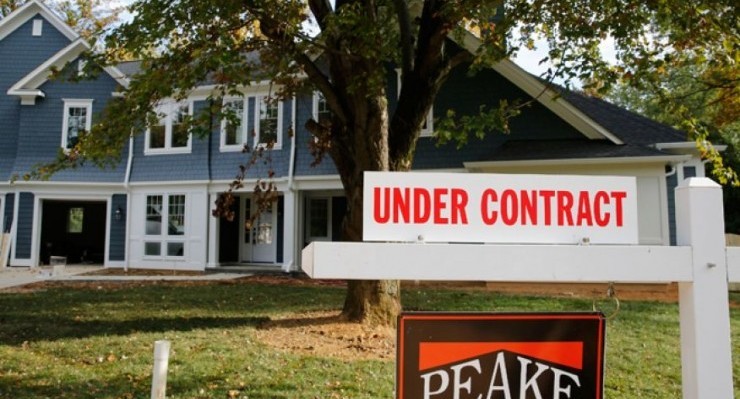

Existing and pending home sales reported by the National Association of Realtors. Photo: Reuters)
The National Association of Realtors (NAR) reported total existing home sales increased 3.2% to a seasonally adjusted annual rate of 5.47 million in September. After a two-month slump, existing home sales by first-time buyers hit a 34% market share, the highest in more than four years. Further, all regions saw an increase in closings last month and distressed sales fell to a new low of 4% of the market.
Total existing-home sales are completed transactions that include single-family homes, townhomes, condominiums and co-ops. The median forecast called for 5.35 million units
“The home search over the past several months for a lot of prospective buyers, and especially for first-time buyers, took longer than usual because of the competition for the minimal amount of homes for sale,” Lawrence Yun, NAR chief economist said. “Most families and move-up buyers look to close before the new school year starts. Their diminishing presence from the market towards the end of summer created more opportunities for aspiring first-time homeowners to buy last month.”
Sales are at their highest pace since June (5.57 million) and are 0.6% above a year ago (5.44 million). While it’s a welcomed sign for many housing market analysts, it is only one piece of the puzzle for what is still a struggling sector. A report on new home construction and building permits was not optimistic, with starts plunging 9% over the last month.
“Inventory has been extremely tight all year and is unlikely to improve now that the seasonal decline in listings is about to kick in,” Mr. Yun said. “Unfortunately, there won’t be much relief from new home construction, which continues to be grossly inadequate in relation to demand.”
Mr. Yun said he is optimistic that the the gain in market share for first-time buyers can hold for the rest of the year and into next spring.
“The market fundamentals — primarily consistent job gains and affordable mortgage rates — are there for the steady rise in first-timers needed to finally reverse the decline in the homeownership rate,” he added.
But not everyone believes the spike in first-time buyers is all good news and certainly not a result of organic demand or strong market fundamentals. Edward Pinto, the former executive vice president and chief credit officer for Fannie Mae, says looser lending practices not only translates into more contracts but also more risk, which led to the housing bubble and fueled the Great Recession.
“As a result of loose lending and accommodative monetary policy, the nominal house price-to-income ratio stands at 3.34, up 10% since the early-2012 trough, thus retracing about a third of drop from the 2006 peak to the 2012 trough,” said Mr. Pinto, now the co-director of the American Enterprise Institute’s (AEI’s) International Center on Housing Risk.
Mr. Pinto is behind the National Mortgage Risk Index (NMRI), which measures how government-guaranteed loans with a first payment date in a given month would perform if subjected to the same stress as in the financial crisis that began in 2007. His views differ greatly than from those at NAR and Realtors, which he and his co-director Stephen Oliner, a senior fellow at UCLA’s Ziman Center for Real Estate, call “the housing lobby.”
“An increasing share of home buyers are taking out mortgages with burdensome monthly payments,” Mr. Oliner said. “Indeed, more than a quarter of recent government-guaranteed home purchase loans had a debt-to-income ratio that exceeded the limit set by the Qualified Mortgage rules in the wake of the financial crisis.”
NAR President Tom Salomone, broker-owner of Real Estate II Inc. in Coral Springs, Florida said government-sponsored enterprises Fannie Mae and Freddie Mac have a duty to ensure there’s access to mortgage credit for creditworthy borrowers wanting to buy a home.
“Unfortunately, overly burdensome fees at the GSEs are making homeownership difficult for moderate-income buyers. Fannie and Freddie can reduce the cost of borrowing while still protecting taxpayers, and we’re hopeful they’ll take these steps to ensure prospective buyers are able to enter the market,” Mr. Salomone said.
Video and regional breakdown via the National Association of Realtors below:
[brid video=”69985″ player=”2077″ title=”Firsttime Buyers Steer ExistingHome Sales Higher in September”]
Regional Breakdown
September existing-home sales in the Northeast leapt 5.7 percent to an annual rate of 740,000, which is unchanged from a year ago. The median price in the Northeast was $261,600, which is 2.1 percent above September 2015.
In the Midwest, existing-home sales grew 3.9 percent to an annual rate of 1.32 million in September, and are now 2.3 percent above a year ago. The median price in the Midwest was $184,500, up 5.9 percent from a year ago.
Existing-home sales in the South in September ticked up 0.9 percent to an annual rate of 2.16 million, but are still 0.9 percent below September 2015. The median price in the South was $204,000, up 6.6 percent from a year ago.
Existing-home sales in the West jumped 5.0 percent to an annual rate of 1.25 million in September, and are now 1.6 percent higher than a year ago. The median price in the West was $345,400, up 8.1 percent from September 2015.







asdfasdf / October 20, 2016
Didn’t we just go through this a decade ago?
/
John Galt / October 22, 2016
@PPDNews pretty much the same problem that got us into this mess to begin with #Bubble
/